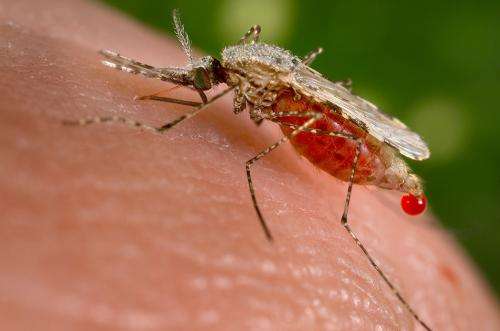Five-year WHO investigation: Treated bed nets still fending off malaria in Africa and India

Bed nets treated with a safe chemical killer still provide significant protection from malaria-carrying mosquitoes, despite the rise in insecticide resistance, according to a major study released today at the annual meeting of the American Society of Tropical Medicine and Hygiene (ASTMH).
The five-year, five-country investigation, coordinated by the World Health Organization (WHO) with financial support from the Bill & Melinda Gates Foundation, is the most comprehensive evaluation ever to assess the impact of insecticide resistance on essential control tools targeted against malaria-carrying mosquitoes—primarily long-lasting insecticidal nets, or LLINs, which have played a central role in cutting malaria cases and deaths worldwide since 2000.
Researchers found that people who slept under LLINs in 340 locations across five countries—Benin, Cameroon, India, Kenya and Sudan—had significantly lower rates of malaria infection than those who did not use a net, even though mosquitoes showed resistance to insecticides at all locations.
"The key finding of this study is that treated nets continue to be a highly effective tool in the malaria fight," said Dr. Pedro Alonso, Director of the WHO Global Malaria Programme. "The study supports WHO's continued call for achieving universal coverage of LLINs for all populations at risk of malaria."
In recent years, LLINs have been the cornerstone of malaria control efforts in sub-Saharan Africa, which shoulders an estimated 90% of the global malaria burden. Between 2000 and 2015, access to a treated net among populations in this region rose from less than 2% to 53%.
WHO estimates that 663 million malaria infections were prevented in sub-Saharan Africa through malaria interventions between 2001 and 2015; treated nets accounted for most cases prevented (69%), followed by artemisinin-based combination therapies (21%) and indoor residual spraying (10%).
Researchers attributed the continued efficacy of LLINs to the combined effect of the barrier provided by the nets and the insecticides themselves. They noted that, even in areas where mosquitoes have developed resistance to the insecticide class used in LLINs (pyrethroids), treated nets can still kill the mosquitoes.
"A resistant mosquito may not die immediately after landing on a net, but it could continue to absorb insecticide as it seeks a way to get through and bite a person beneath the net," said Dr. Tessa Knox, a WHO scientist involved in the evaluation. "This may eventually kill the mosquito and stop onward transmission of malaria parasites," she added.
The fact that LLINs remain effective is an indication that resistance is not an all-or-nothing proposition and that pyrethroids are likely retaining some level of impact in many areas, said Dr. Knox.
The findings of this WHO study are consistent with recent research conducted by the Centers for Disease Control and Prevention (CDC). The CDC study, published in the Malaria Journal in 2015, showed that treated nets provided significant protection among children in an area of Malawi with considerable malaria transmission and moderate levels of mosquito resistance to pyrethroids.
New tools urgently needed
While these findings are encouraging, WHO continues to highlight the urgent need for new and improved malaria-fighting tools to accelerate progress towards global elimination goals. WHO is calling for greater investments in vector control interventions, such as LLINs and indoor residual spraying, improved diagnostics and more effective medicines.
A promising pipeline of new anti-mosquito tools is currently under development. WHO is revising its process for reviewing and recommending new malaria vector interventions in order to fast-track their route to the field.
Resistance still a key concern
Mosquito resistance to insecticides remains a growing concern. According to WHO estimates, 60 countries have reported mosquito resistance to at least one of the four insecticides used in LLINs and indoor residual spraying since 2010; of these, 49 countries have reported resistance to two or more insecticide classes. If resistance continues to intensify, the mosquito-killing capacity of LLINs and indoor residual spraying may steadily weaken.
To prevent an erosion of the impact of these core vector control tools, WHO officials highlight the need for all countries with ongoing malaria transmission to develop and apply effective insecticide resistance management strategies. Information should be leveraged to inform timely decisions on which tools to apply where, and when.
For example, at one study site in Sudan, researchers found that spraying the walls of homes with an insecticide that is different from what is used in bed nets reduced malaria infections by an additional 50 percent, compared with LLINs alone. Encouragingly, mosquito resistance to pyrethroids was slowed, showing that careful use of available options can help counter resistance.
"This study provides encouraging news that we have not yet run out of time in battling insecticide resistance," said Stephen Higgs, PhD, president of the American Society of Tropical Medicine and Hygiene. "However, we must take advantage of the time we now have to invest in research and generate new tools that will allow us to finally defeat this complex and challenging disease."
Dr. Alonso noted that a global strategy for comprehensive control of disease-carrying insects should be high on the agenda for the 2017 World Health Assembly. He said there is a growing need for sustainable approaches supported by enhanced expertise to aid the fight against malaria and a variety of other mosquito-borne diseases, such as Zika, dengue and chikungunya and also yellow fever, which is now resurgent in parts of Africa.
More information: Kim A Lindblade et al. A cohort study of the effectiveness of insecticide-treated bed nets to prevent malaria in an area of moderate pyrethroid resistance, Malawi, Malaria Journal (2015). DOI: 10.1186/s12936-015-0554-1



















